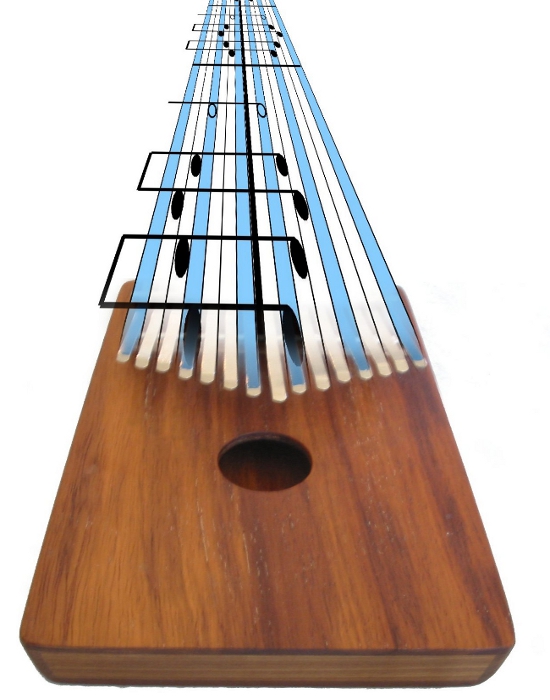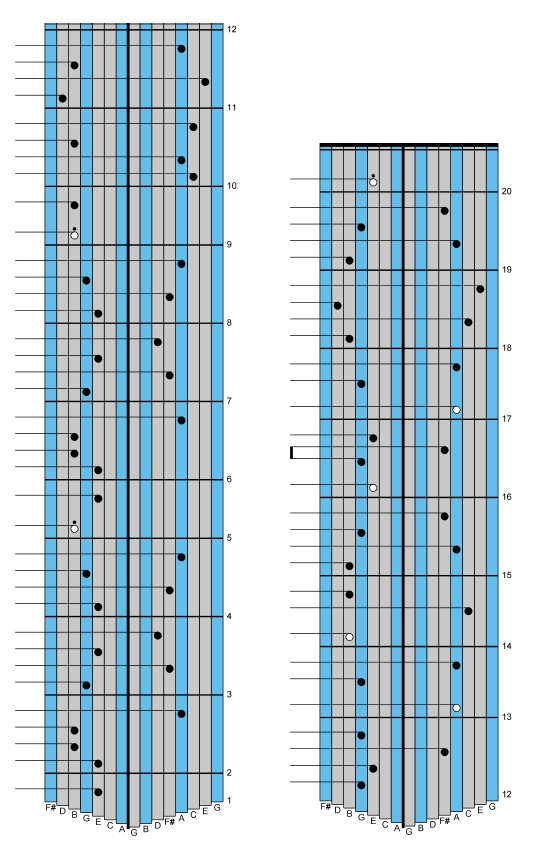
Use of this website constitutes acceptance of the Privacy Policy and User Agreement. Copyright © 2020 Kalimba Magic. All Rights Reserved.
I’ve heard this story from more than a hundred people by now: people had been living under the burden of the belief that they were simply unable to make music, but then they discovered the kalimba, and they discovered they could make music on the kalimba, and they were even appreciated for the music they were able to make.
If you are reading these words, you probably know you can make music. But you might be convinced that you cannot read tablature.
This blog post is a message to you: you CAN read tablature, and you CAN play songs that everyone around you will recognize. And Christmas carols are the perfect place to start.
The music you hear when you load the page, or when you start the media player near the bottom of this page, is, of course, “God Rest Ye Merry, Gentlemen” – the old Christmas carol, in a simple melody-only arrangement, which you can see in the tablature below.
The Alto, Treble, or Bb Treble kalimbas are the best instruments for playing Christmas carols. The recording and the tablature below are both for the Alto kalimba. The Bb Treble reads Alto tablature, but the standard Treble needs its own separate tablature.
Look at the tablature as a very simple map of the kalimba tines. If you can follow a road map, then you can follow a kalimba map, and consequently it should be pretty simple to make nice sounds on the instrument.

The tablature, or tab, is a map of the kalimba and shows you which tines to play. Each type of kalimba has a different tablature, matching its particular pattern of tines. The tablature shown here is for the Alto kalimba.
Christmas carols are the perfect place to start learning tablature because you already know how the music sounds. You can probably sing a number of carols without thinking. This knowledge really helps a lot when you are first exploring reading the new kalimba map.
This arrangement is from our book “Christmas Carols for the Alto and Treble Kalimba” – see the link at the end of the article.

An elementary version of “God Rest Ye Merry Gentlemen” for the Alto kalimba. Click to download free Alto tablature PDF.
If you have never tried to read tablature, I have three suggestions for you. First look at the measure numbers on the right side of each tab column, increasing sequentially from “1” to “20”. These are the measure numbers, and they give you a clue that you start reading the tablature in the lower left corner and go up the page, and then jump over to the lower right and again proceed up the page.
The next thing to notice is how there are 15 tiny columns within each main column of Alto kalimba tablature. They represent the 15 tines of the Alto kalimba. Nine are gray and these represent the Alto’s silver, unpainted tines, and six are blue and they represent the painted tines.
The final thing to notice in kalimba tablature is the notes – the solid or hollow circles placed on the tines, with thin lines that go off to the left. Different types of notes are held for different lengths of time, but no need to worry about that. You KNOW how this song goes, and with the melody in your head or in your ears, you will just follow along. Or if this carol is new to you, just listen to it playing when this page is loaded.
In measure 1, there is only a single note – an E. (The note names, which indicate what that tine is tuned to, are at the bottom of the tablature.) The next note, in measure 2, is also an E, so two E notes are played in a row. Then going up the page, the following note is a B – which is also repeated. In jumping from the E to the B, you need to skip over one tine – the painted tine in the middle of the left side.
The last note of measure 2 is an A, the painted tine in the middle of the right side. It is the first note to be played on the right side. The solid black vertical line running at the center of the tablature is an invisible left-right division. Your fingers can cross over that line, but usually they don’t. The low G, the longest tine right in the middle, is to the right of the heavy black line, so it belongs to the right thumb.
Starting with the second B of measure 2, there are 11 notes in a row that are adjacent to each other in the scale, and are played by alternating left-right. When alternating sides like this, going up or down a scale, it is actually very easy to get a little lost and make an error. Pay careful attention to the painted tines as guide posts. The scheme of how the tines are painted will help you traverse the scales correctly. Study that scheme and your movements on the kalimba will become more sure as you go along.
Even though the alternating thumb scales are a bit tricky at first, with practice you will find that these scales are actually very easy to play, and and their alternating-side nature makes them easy to play quickly.
Another thing that makes this arrangement easy is that there are no chords to play. There is only one note at a time, spelling out the melody of a well-known song. One of the best-known songs!
While reading tablature off a page or off the computer screen, attempt to watch the tablature, but don’t watch your kalimba. Can you play your kalimba without looking at it? Once you have started correctly, with your thumbs on the right tines, it’s all about increments – how many tines do you need to move to the left or to the right of the tine you just played.
If you like playing “God Rest Ye Merry, Gentlemen,” please note that Kalimba Magic has a book of similar music, “Christmas Carols for the Alto and Treble Kalimbas”. Not all of the book is easy, but a lot of it is just as easy as this song. The beginning of the book has easy carols and as you go deeper into the book, the songs progressively have more going on: harmony notes and even counterpoint are added as the tunes becomes more complex.
I find the voice of the kalimba to be so pure and lovely that even a simple, melody-only arrangement such as “God Rest Ye Merry, Gentlemen” can be touching and effective. Stay tuned! Next time, I’ll show you how to add just a few harmony notes to this song to make it even more beautiful!


Sign up for our newsletter and free resources with your email address:
We pinky promise not to spam you and to only send good stuff.
 Assist Paul Tracey Rebuild His House in Pacific Palisades
Assist Paul Tracey Rebuild His House in Pacific Palisades 8-Note Spiral Kalimba Turned into a Student Karimba
8-Note Spiral Kalimba Turned into a Student Karimba Seek to Infuse Your Musical Moments With Beauty and Magic
Seek to Infuse Your Musical Moments With Beauty and MagicUse of this website constitutes acceptance of the Privacy Policy and User Agreement. Copyright © 2020 Kalimba Magic. All Rights Reserved.